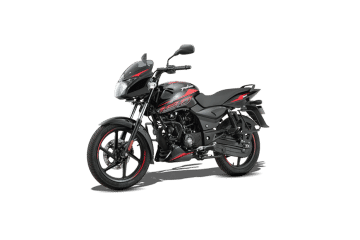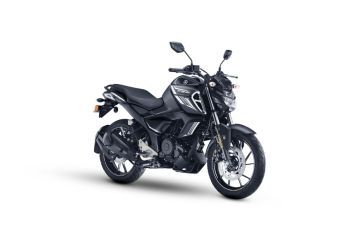Explore all New Cars of 2025
Bajaj Pulsar 150 vs Yamaha FZS-FI V3
Pulsar 150 vs FZS-FI V3
| Key Highlights | Pulsar 150 Single Disc | FZS-FI V3 Matte Red And Matte Grey |
|---|---|---|
| Engine Type | 4-Stroke, 2-Valve, Twin Spark BSVI Compliant DTS-i FI Engine | Air cooled, 4-stroke, SOHC, 2-valve |
| Max Power | 14 PS @ 8500 rpm | 12.4 PS @ 7250 rpm |
-
Bajaj Pulsar 150
 Rs. 1.10 Lakh EMI - Rs. 3,300 View January OffersYamaha FZS-FI V3
Rs. 1.10 Lakh EMI - Rs. 3,300 View January OffersYamaha FZS-FI V3 Rs. 1.22 Lakh EMI - Rs. 3,541 View January Offers
Rs. 1.22 Lakh EMI - Rs. 3,541 View January Offers
Pulsar 150 vs FZS-FI V3 Key Highlights
| Basic Info | Bajaj Pulsar 150 Single Disc | Yamaha FZS-FI V3 Matte Red And Matte Grey |
|---|---|---|
| Rating |
1909 reviews
|
534 reviews
|
| Brand Name | Bajaj | Yamaha |
| Ex-Showroom Price | Rs. 1.10 Lakh Get On-Road Price | Rs. 1.22 Lakh Get On-Road Price |
| Engine Type | 4-Stroke, 2-Valve, Twin Spark BSVI Compliant DTS-i FI Engine | Air cooled, 4-stroke, SOHC, 2-valve |
| Max Power | 14 PS @ 8500 rpm | 12.4 PS @ 7250 rpm |
| Fuel Type | Petrol | Petrol |
| Colors | ||
| Brakes Front | Disc | Disc |
| Brakes Rear | Drum | Disc |
| Wheel Size | Front :-431.8 mm, Rear :-431.8 mm | Front :-431.8 mm,Rear :-431.8 mm |
| Wheels Type (Pressed Steel/ Alloy) | Alloy | Alloy |
| ABS | Single Channel | Single Channel |
| Starting | Kick and Self Start | Self Start Only |
| Speedometer | Digital | Digital |
| EMI |
Rs. 3,300
@
11.99% (36 months)
|
Rs. 3,541
@
9.45% (36 months)
|
| Insurance | Rs. 6,895 Pulsar 150 Insurance | Rs. 7,161 FZS-FI V3 Insurance |
| Brochure |
Download
Brochure
|
Download
Brochure
|
Engine |
|
||||||||||||||||||||||||||||||||||||||||||||||||||||||
|---|---|---|---|---|---|---|---|---|---|---|---|---|---|---|---|---|---|---|---|---|---|---|---|---|---|---|---|---|---|---|---|---|---|---|---|---|---|---|---|---|---|---|---|---|---|---|---|---|---|---|---|---|---|---|---|
Brakes |
|
||||||||||||||||||||||||||||||||||||||||||||||||||||||
Performance |
|
||||||||||||||||||||||||||||||||||||||||||||||||||||||
Tyres |
|
||||||||||||||||||||||||||||||||||||||||||||||||||||||
Dimensions |
|
||||||||||||||||||||||||||||||||||||||||||||||||||||||
Electricals |
|
||||||||||||||||||||||||||||||||||||||||||||||||||||||
Features |
|
Pros and Cons
- Positives
- Negatives
- The fans still like the iconic design
- Slightly sporty yet comfy riding posture
- Big bike styling
- features
- smooth engine.
- Has become pretty pricey today
- Not everyone will dig the dated looks
- Performance isn’t up to the mark
- the quality of plastics feels sub-par.
Is Yamaha FZS-FI V3 Better Than Bajaj Pulsar 150?
58% users have chosen Yamaha FZS-FI V3 over Bajaj Pulsar 150 in a survey being conducted on zigwheels.com.
Apart from this survey a total of 11671 users have also rated Yamaha FZS-FI V3 and Bajaj Pulsar 150 on some really important factors like Mileage , performance, comfort, safety etc. and have given their personal opinions about these bikes.
As per the users experiences Yamaha FZS-FI V3 is a winner for you if you are seriously looking for mileage, performance, comfort and features in your bike. On the basis of maintenance user have rated both the bikes equally.
Before making your decision you should also consider the unbiased and thorough analysis of these bikes on every aspect by our auto experts who have summarised the analysis in pros, cons and final conclusion..
| Ratings Factor | FZS-FI V3 | Pulsar 150 |
|---|---|---|
| Mileage | 4.3 | 3.9 |
| Performance | 4.2 | 4.1 |
| Comfort | 4.4 | 4.1 |
| Maintenance | 3.8 | 3.8 |
| Features | 4.3 | 4.1 |
Videos of Bajaj Pulsar 150 and Yamaha FZS-FI V3
-
5 Bike Launches In June 2022: Bajaj Pulsar N160, Royal Enfield Hunter 350, TVS Zeppelin, And More 1 Jun, 2022 7518 views
-
Bajaj Pulsar 125 Neon Road Test,| Price, Mileage, Performance, Features 6 Sep, 2019 45467 views
-
Bajaj Pulsar 150 (2017) : 0-60 0-100 : PowerDrift 12 Feb, 2017 133635 views
-
Traction Control For Yamaha FZ-S Fi Version 4.0, FZ-X, R15 M, MT-15 V2 | Price & Features | Zigwheels 14 Feb, 2023 8913 views
Bajaj Pulsar 150 Comparison with Similar Bikes
-
 BajajPulsar 150Rs. 1.10 LakhvsPulsar 150 vs Apache RTR 160 4V
BajajPulsar 150Rs. 1.10 LakhvsPulsar 150 vs Apache RTR 160 4V TVSApache RTR 160 4VRs. 1.24 Lakh
TVSApache RTR 160 4VRs. 1.24 Lakh
yamaha fz s fi version 3 Comparison with Similar Bikes
-
 YamahaFZS-FI V3Rs. 1.22 LakhvsFZS-FI V3 vs Apache RTR 160 4V
YamahaFZS-FI V3Rs. 1.22 LakhvsFZS-FI V3 vs Apache RTR 160 4V TVSApache RTR 160 4VRs. 1.24 Lakh
TVSApache RTR 160 4VRs. 1.24 Lakh
Latest News on Bajaj Pulsar 150 and Yamaha FZS-FI V3
-
 Bajaj Sales Report: November 20245 Dec, 2024 | By Team ZigWheels
Bajaj Sales Report: November 20245 Dec, 2024 | By Team ZigWheels -
 Yamaha Announces Festive Offers For FZ-Fi, FZ-S Fi V3 and V4, Fascino And RayZR 125 Fi Hybrid26 Sep, 2024 | By Team ZigWheels
Yamaha Announces Festive Offers For FZ-Fi, FZ-S Fi V3 and V4, Fascino And RayZR 125 Fi Hybrid26 Sep, 2024 | By Team ZigWheels -
 Bajaj Pulsar Lineup Festive Offers Announced1 Oct, 2024 | By Team ZigWheels
Bajaj Pulsar Lineup Festive Offers Announced1 Oct, 2024 | By Team ZigWheels -
 Yamaha FZ-S FI V4 vs TVS Apache RTR 160: Features Compared20 Feb, 2023 | By Team ZigWheels
Yamaha FZ-S FI V4 vs TVS Apache RTR 160: Features Compared20 Feb, 2023 | By Team ZigWheels -
 Hero Xtreme 160R 2V: Same Price Other Options19 Sep, 2024 | By Team ZigWheels
Hero Xtreme 160R 2V: Same Price Other Options19 Sep, 2024 | By Team ZigWheels -
 Yamaha FZ-S V4 Vs FZ-S V3: New Vs Old In 5 Pics13 Feb, 2023 | By Team ZigWheels
Yamaha FZ-S V4 Vs FZ-S V3: New Vs Old In 5 Pics13 Feb, 2023 | By Team ZigWheels -
 OG Bajaj Pulsar DTS-i Gets An Epic Makeover17 Aug, 2024 | By Team ZigWheels
OG Bajaj Pulsar DTS-i Gets An Epic Makeover17 Aug, 2024 | By Team ZigWheels -
 Alcohol-guzzling Bikes Showcased at Auto Expo13 Jan, 2023 | By Team ZigWheels
Alcohol-guzzling Bikes Showcased at Auto Expo13 Jan, 2023 | By Team ZigWheels -
 BREAKING: 2024 Bajaj Pulsar 125, Pulsar 150, Pulsar N160 And Pulsar 220F Launched: Get New Features & Graphics14 Jun, 2024 | By Team ZigWheels
BREAKING: 2024 Bajaj Pulsar 125, Pulsar 150, Pulsar N160 And Pulsar 220F Launched: Get New Features & Graphics14 Jun, 2024 | By Team ZigWheels -
 Key Highlights Of The 2022 Yamaha FZ-S Version 3.05 Jan, 2022 | By Team ZigWheels
Key Highlights Of The 2022 Yamaha FZ-S Version 3.05 Jan, 2022 | By Team ZigWheels
Recently Asked User Questions
- Selecting the right vehicle would depend on several factors such as your budget preference on the segment, features required, engine options, brand preference, etc. The Pulsar 150 continues to be the most popular 150cc motorcycle that offers a decent combination of power, features, and efficiency at a good price. On the other hand, the Apache RTR 160 4V comes with plenty of power on tap along, it still remains one of the most exciting motorcycles to ride in the 160cc segment. It offers a very good ride quality and it has a smooth engine which is good for the daily commute. Moreover, we would suggest you to take a test ride before making the final decision. Follow the link and select your desired city for dealership details.
- Both the bikes are good in their forte. In nearly every aspect, except maybe ergonomics and braking, the Yamaha FZS-FI v3.0 fails to impress. While its motor offers better fuel efficiency compared to the previous-gen model, it lacks grunt. If you have around Rs 1 lakh to invest, you're better off with say a TVS Apache RTR 160 4V, Bajaj Pulsar NS 160 or the Suzuki Gixxer. Whereas, the Yamaha MT 15 BS6 is more than just the R15 v3 sans fairing. The naked looks sharp is light and can be a hoot to commute. However, the compact riding posture might be a bit too tight for large riders. What is also disheartening is the poor switchgear and build quality as well as the lack of dual-channel ABS. Moreover, we would suggest you to take a test ride for a better understanding of performance and comfort. Click on the link and select your desired city for dealership details.
- Selecting the right bike would depend on several factors such as your budget preference on the segment, features required, engine options, brand preference, etc. In nearly every aspect, except maybe ergonomics and braking, the Yamaha FZS-FI v3.0 fails to impress. While its motor offers better fuel efficiency compared to the previous-gen model, it lacks grunt. If you have around Rs 1 lakh to invest, you're better off with say a TVS Apache RTR 160 4V, Bajaj Pulsar NS 160, or the Suzuki Gixxer. Yamaha FZS-FI V3 is powered by a 149 cc engine. This FZS-FI V3 engine generates a power of 12.4 PS @ 7250 rpm and a torque of 13.3 Nm @ 5500 rpm. The claimed mileage of FZS-FI V3 is 55.42 kmpl. On the other hand, The TVS Apache RTR 160 4V has been the benchmark when it comes to 160cc motorcycles. With the BS6-compliant iteration, TVS has made sure it is still as sprightly, with the '21 update making it the most powerful bike in the 160cc sporty commuter class. The overall package and reasonable pricing make it a true value-for-money motorcycle in its segment. TVS Apache RTR 160 4V is powered by a 159.7 cc engine. This Apache 160 4V engine generates a power of 17.63 PS @ 9250 rpm and a torque of 14.73 Nm @ 7250 rpm. Moreover, we would suggest you to take a test ride before making the final decision. Follow the link and select your desired city for dealership.













